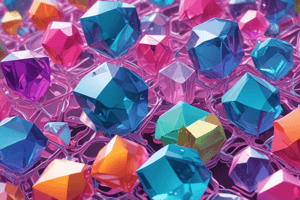Podcast
Questions and Answers
Which part of an atom plays a crucial role in chemical bonding between atoms?
Which part of an atom plays a crucial role in chemical bonding between atoms?
- The nucleus
- The valence shell (correct)
- The protons
- The neutrons
What is the primary purpose of cell division?
What is the primary purpose of cell division?
- To synthesize proteins
- To produce new cells for growth and repair (correct)
- To create genetic variation in offspring
- To facilitate cellular respiration
During which phase of mitosis do the chromosomes condense and become visible?
During which phase of mitosis do the chromosomes condense and become visible?
- Prophase (correct)
- Telophase
- Metaphase
- Anaphase
How many genetically unique daughter cells are produced through meiosis?
How many genetically unique daughter cells are produced through meiosis?
What is the ploidy (number of chromosome sets) of the daughter cells resulting from mitosis?
What is the ploidy (number of chromosome sets) of the daughter cells resulting from mitosis?
Which process involves two successive rounds of cell division to produce haploid daughter cells?
Which process involves two successive rounds of cell division to produce haploid daughter cells?
What are the three main components of an atom?
What are the three main components of an atom?
Which subatomic particles are found in the nucleus of an atom?
Which subatomic particles are found in the nucleus of an atom?
Where do electrons reside in an atom?
Where do electrons reside in an atom?
Which component of an atom has no charge?
Which component of an atom has no charge?
Which term refers to the distinct energy levels where electrons orbit the nucleus?
Which term refers to the distinct energy levels where electrons orbit the nucleus?
What determines the type of element represented by an atom?
What determines the type of element represented by an atom?
Flashcards are hidden until you start studying
Study Notes
Science: Understanding Atoms and Cell Division
Science is the pursuit of knowledge through systematic observation and experimentation. It encompasses various fields, from physics and chemistry to biology and beyond. In this context, we will explore two fundamental aspects of science: the structure of atoms and the process of cell division.
Parts of an Atom
Atoms are the basic building blocks of all matter. They consist of three main components: protons, neutrons, and electrons. Protons are positively charged particles found in the nucleus of an atom, while neutrons have no charge and also reside within the nucleus. Electrons, on the other hand, are negatively charged particles that orbit around the nucleus in specific energy levels called electron shells.
Protons and Neutrons
Protons and neutrons are collectively known as nucleons because they exist within the atomic nucleus. Nuclei can contain varying numbers of these particles, which determine the type of element represented by the atom. For example, an atom with one proton and one neutron is hydrogen-1 (H), while helium-4 (He) has two protons and two neutrons.
Electrons
Electrons are subatomic particles that surround the nucleus of an atom in distinct energy levels. These concentric layers, referred to as electron shells, hold a specific number of electrons, following the rules of quantum mechanics. An outermost shell containing only one electron is typically called the valence shell, as it plays a crucial role in chemical bonding between atoms.
Cell Division
Cell division is the process by which cells replicate and create two identical daughter cells. This mechanism ensures growth, maintenance, and repair of tissues throughout the body. There are several types of cell division, including mitosis and meiosis.
Mitosis
Mitosis is a form of cell division that produces two genetically identical daughter cells from a single parent cell. It involves five consecutive phases: prophase, metaphase, anaphase, telophase, and cytokinesis. During this process, the chromosomes condense into visible structures, separate, and ultimately distribute evenly across the dividing cell.
Meiosis
Meiosis, another type of cell division, produces four genetically unique gametes (sex cells) from a single diploid (two sets of chromosomes) parent cell. Unlike mitosis, meiosis undergoes two successive rounds of cell division, resulting in four haploid (single set of chromosomes) daughter cells. This allows for genetic variation in offspring when the haploid cells combine during fertilization.
In conclusion, understanding the intricacies of atoms and their constituents, as well as the processes that govern cell division, provides valuable insights into the foundations of science. These concepts are essential for comprehending the molecular structures that make up our world and the biological mechanisms that contribute to growth and reproduction.
Studying That Suits You
Use AI to generate personalized quizzes and flashcards to suit your learning preferences.




